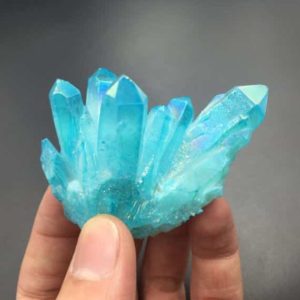
What is Quartz?
Quartz is a crystalline, strong mineral made up of silicon and oxygen atoms. The atoms are linked in a continuous SiO4 Silicon–oxygen tetrahedra structure, with each oxygen being shared between two tetrahedra, giving SiO2 an overall chemical formula. Quartz is the second most abundant of minerals in the continental crust of Earth, behind feldspar.
Quartz occurs in two types, normal α-quartz and high-temperature β-quartz, both chiral. The transformation from α-quartz to β-quartz occurs abruptly at 573 ° C (846 K; 1.063 ° F). Since the transformation is followed by a major volume change, it can easily trigger the fracturing of ceramics or rocks that pass this temperature threshold.
There are several different quartz types and some semi-precious gemstones. Quartz varieties have been the most widely used minerals in jewelry making and hardstone carvings since the antiquity, particularly in Eurasia.
Quartz belongs to the trigonal crystal system. The ideal crystal shape is a six-sided prism terminating with six-sided pyramids at each end. In nature quartz crystals are often twinned (with twin right-handed and left-handed quartz crystals), distorted, or so intergrown with adjacent crystals of quartz or other minerals as to only show part of this shape, or to lack obvious crystal faces altogether and appear massive. Well-formed crystals typically form in a ‘bed’ that has unconstrained growth into a void; usually the crystals are attached at the other end to a matrix and only one termination pyramid is present. However, doubly terminated crystals do occur where they develop freely without attachment, for instance within gypsum. A quartz geode is such a situation where the void is approximately spherical in shape, lined with a bed of crystals pointing inward.
What is Blue Quartz?
An opaque to translucent, blue quartz variety due to inclusions of its color, typically fibrous magnesioriebeckite or crocidolite, or tourmaline. The color can be caused by the color of the minerals used, or by microscopic inclusions of Rayleigh light scattering.
Blue quartz contains inclusions of fibrous magnesio-riebeckite or crocidolite.
How does Blue Quartz from?
Blue quartz formation may depend on the type of inclusion to which it relates. Within metamorphic rocks, the blue quartz with mineral inclusions typically crystallizes. Nevertheless, those where tourmaline inclusions predominate usually occur in igneous rocks and pegmatites. Coarse-grained blue quartz is often used to form the constituents of igneous rocks.
Where does Blue Quartz come from?
Quartz is a very common mineral throughout the world, having important deposits in the Americas, specifically in the United States, Colombia, Venezuela, and Brazil, in the European continent, this precious mineral can also be found in Spain, Switzerland, Italy and even in more remote areas such as the island of Madagascar.
How to identify Blue Quartz?
In the jewelry world one of the most common fakes is selling tinted glass as if it were blue quartz. In order to avoid anything like this from happening to us, you need to learn certain quartz physical characteristics this separate them from the rest.
While it sounds like a natural science lesson, identifying them in a very simple way is very useful knowledge. The first thing you should know about quartz is that it has a higher hardness than glass so you can do a simple test to verify whether you have an authentic piece.
A piece of quartz would be able to crack glass with a higher hardness, and you can try a glass bottle and if the stone scratches it is quartz with ease. In the other side, if it takes an enormous effort to create a crack in the bottle we can face a plain piece of glass.
The trick we’ve just discussed is a piece of homemade advice you can do at any time, but if you’d like anything more sophisticated you’ll need some jeweler loupes. Magnifying glasses are required to test whether or not there are bubbles in the composition of the rock.










